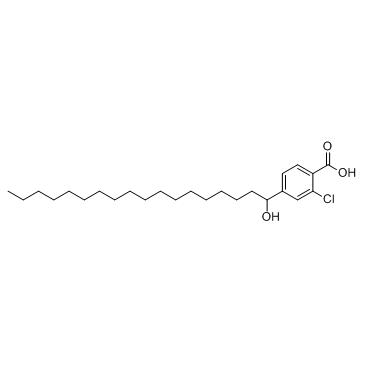| Description |
Lodelaben is a human neutrophil elastase inhibitor with an IC50 and Ki of 0.5 and 1.5 μM, respectively.
|
| Related Catalog |
|
| Target |
IC50: 0.5 μM (elastase)[1] Ki: 1.5 μM (elastase)[1]
|
| In Vitro |
Lodelaben is a human neutrophil elastase inhibitor with an IC50 and Ki of 0.5 and 1.5 μM, respectively. Results indicate that the inhibition of human neutrophil elastase (HNE) by Lodelaben is non-competetive. Lodelaben is not inhibitory at 10 μM with the synthetic substrates or at 5 μM vith Azocoll. Pseudomonas aeruginosa elastase, a metallo-protease is not inhibited by Lodelaben. Cathepsin G activity, however, is inhibited by Lodelaben, with an IC50 of approximately 2.5 μM, with Azocoll as substrate[1].
|
| In Vivo |
The mean pulmonary artery pressures of the saline/vehicle and saline/Lodelaben groups are similar, 16.4±1.1 and 17.4±0.9 mm Hg, respectively. Although, mean pulmonary artery pressure in the monocrotaline/vehicle group is 27.5±0.8 mm Hg, treatment of monocrotaline rats with Lodelaben results in significantly lower values (21.00±1.6 mm Hg, p<0.05). Saline/vehicle and saline/Lodelaben rats have only a small percentage of arteries muscularized at the alveolar wall level (1.9±1.4 and 0.4±0.4%, respectively). Treatment of monocrotaline-injected rats with Lodelaben results in a decreased percentage of alveolar wall arteries muscularized (10.0±3.6%)[2].
|
| Kinase Assay |
Human neutrophil elastase (HNE) activity is quantitated by two assay systems. In the first, the rate of hydrolysis of MeOS-AAPV-NA is monitored spectrophotometrically at 410 nm, in the presence or absence of Lodelaben. The elastase concentration is titrated to yield an absorption change of 0.12 to 0.14 optical density units/min, at 30°C, in 0.2 M Tris buffet, pH 8. Lodelaben and substrate are prepared in dimethylsulfoxide (DHSO). The final DMSO concentration is 10%. In the second method, the hydrolysis of [14C]elelastin by HNE in the presence and absence of Lodelaben is quantitated[1].
|
| Animal Admin |
Pathogen-free male Sprague-Dawley rats (250 to 300 g) are used. Half are assigned at random to be given a single subcutaneous injection of monocrotaline (60 mg/kg) and the other half receive an equal volume of 0.9% saline. Half of the rats in each group are further assigned at random to receive by gavage either Lodelaben (40 mg/kg/dose) suspended in carboxymethylcellulose vehicle or an equal volume of vehicle only. The rats are gavaged twice daily starting 12 hours before and continuing for 8 days after the monocrotaline or saline injection to provide a "window" around day 4. On day 13, after the monocrotaline or saline injection, the rats are anesthetized. Pressure measurements and cardiac output are recorded 48 hours later to allow sufficient time for recovery from the effects of anesthesia. The heart and lungs are then prepared for morphological assessments[2].
|
| References |
[1]. Nakao A, et al. SC-39026, a specific human neutrophil elastase inhibitor. Biochem Biophys Res Commun. 1987 Sep 15;147(2):666-74. [2]. Ilkiw R, et al. SC-39026, a serine elastase inhibitor, prevents muscularization of peripheral arteries, suggesting a mechanism of monocrotaline-induced pulmonary hypertension in rats. Circ Res. 1989 Apr;64(4):814-25.
|
